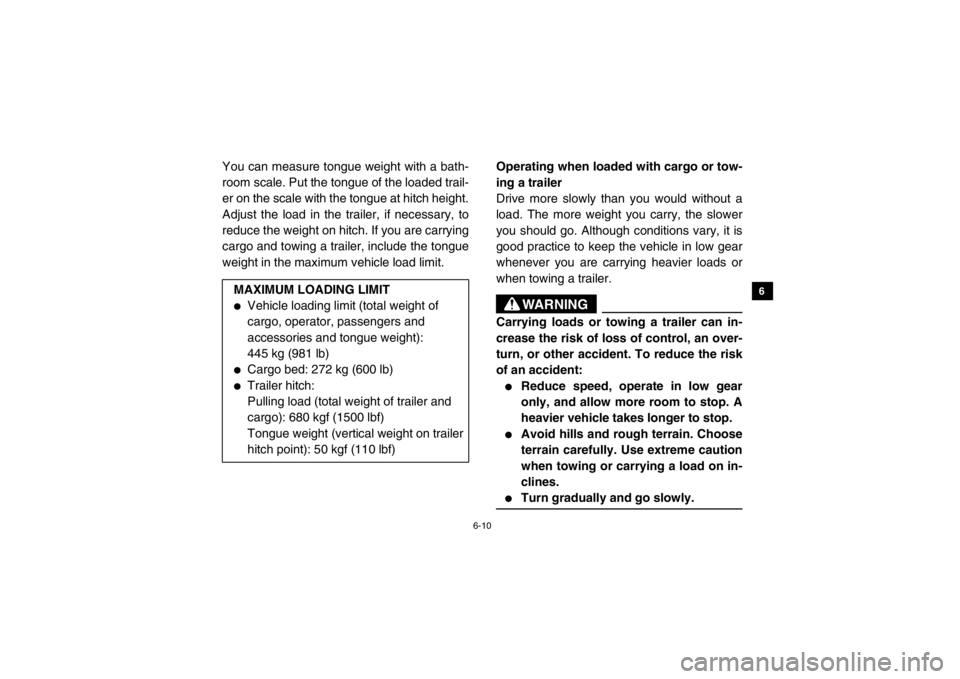Page 81 of 180
6-8
1
2
3
4
56
7
8
9
10
11
12
13
14
EVU01210ParkingWhen parking, stop the engine and shift the
drive select lever into the neutral position. Ap-
ply the parking brake to help prevent the vehi-
cle from rolling. See pages 7-19 for more
information on parking and parking on a
slope.
EVU00630LoadingTake extra precautions when driving with a
load or trailer. Follow these instructions and
always use common sense and good judg-
ment when carrying cargo or towing a trailer.
1XP7B_EE.book Page 8 Tuesday, February 4, 2014 3:40 PM
Page 82 of 180

6-9
6
7
8
9
10
11
12
13
14
Prepare your load or trailer
WARNING
Improper loading or towing can increase
the risk of loss of control, an overturn, or
other accident:●
Do not exceed the Maximum Loading
Limits for the vehicle (see page 6-10
and vehicle labeling).
●
Keep weight in the cargo bed centered
side to side, and as low and as far for-
ward as possible. Top-heavy loads in-
crease the risk of overturn. Be sure
cargo is secured – a loose load could
change handling unexpectedly or
strike occupants.
●
Do not exceed the maximum tongue
weight.
●
Make sure the load does not interfere
with your control or ability to see
where you are going.
●
Tie down cargo in the trailer securely.
Make sure cargo in the trailer cannot
move around. A shifting load can
cause an accident.
Use the hooks equipped on the cargo bed to
tie down loads.
Choose a trailer hitch drawbar designed for
use with a 5 cm (2 in) receiver. (See page
4-28 for more information.)
1XP7B_EE.book Page 9 Tuesday, February 4, 2014 3:40 PM
Page 83 of 180

6-10
1
2
3
4
56
7
8
9
10
11
12
13
14
You can measure tongue weight with a bath-
room scale. Put the tongue of the loaded trail-
er on the scale with the tongue at hitch height.
Adjust the load in the trailer, if necessary, to
reduce the weight on hitch. If you are carrying
cargo and towing a trailer, include the tongue
weight in the maximum vehicle load limit.Operating when loaded with cargo or tow-
ing a trailer
Drive more slowly than you would without a
load. The more weight you carry, the slower
you should go. Although conditions vary, it is
good practice to keep the vehicle in low gear
whenever you are carrying heavier loads or
when towing a trailer.
WARNING
Carrying loads or towing a trailer can in-
crease the risk of loss of control, an over-
turn, or other accident. To reduce the risk
of an accident:●
Reduce speed, operate in low gear
only, and allow more room to stop. A
heavier vehicle takes longer to stop.
●
Avoid hills and rough terrain. Choose
terrain carefully. Use extreme caution
when towing or carrying a load on in-
clines.
●
Turn gradually and go slowly.
MAXIMUM LOADING LIMIT●
Vehicle loading limit (total weight of
cargo, operator, passengers and
accessories and tongue weight):
445 kg (981 lb)
●
Cargo bed: 272 kg (600 lb)
●
Trailer hitch:
Pulling load (total weight of trailer and
cargo): 680 kgf (1500 lbf)
Tongue weight (vertical weight on trailer
hitch point): 50 kgf (110 lbf)
1XP7B_EE.book Page 10 Tuesday, February 4, 2014 3:40 PM
Page 84 of 180
6-11
6
7
8
9
10
11
12
13
14
Pulling something other than a trailer
Yamaha recommends that loads be transport- ed in the bed or in a trailer. If you need to
move an object a short distance use a winch
and follow the winch manufacturer’s instruc-
tions.
If you choose to use something other than a
winch use extreme caution, follow the manu-
facturer’s instructions for that product, and
only attach to the hitch or hitch bracket of the
Viking. WARNING! Improperly pulling can
cause serious injury or death. Never ex-
ceed the pulling load limit of the Viking.
Avoid pulling on inclines.
Pulling objects on the ground can be more
hazardous than pulling a trailer. It may be dif-
ficult to predict how the load will affect vehicle
operation. That effect could also change de-
pending upon terrain or what obstacles might
be in the object’s path.1XP7B_EE.book Page 11 Tuesday, February 4, 2014 3:40 PM
Page 104 of 180

7-20
7
8
9
10
11
12
13
14
4. With the brake pedal applied, set the parking brake.
5. Block the front and rear wheels with
rocks or other objects.
Loading
The total weight of operator, passengers, ac-
cessories, cargo, trailer tongue weight, and
the vehicle itself must not exceed 1080 kg
(2381 lb). Vehicle loading can affect handling.
See “Loading” on page 6-8.
Operation on differe nt surfaces and
terrainsGo slowly and proceed with caution when op-
erating on an unfamiliar surface or terrain.
This vehicle may handle differently in certain
types of terrains or on certain surfaces. You
may come upon hidden rocks, bumps, or
holes without enough time to react. To avoid
loss of control or rollover, always be alert to
changing surfaces or terrain when operating
the vehicle.
Your Yamaha Viking has higher ground clear-
ance and other features to handle rugged ter-
rain, and as a result, can overturn in situations
where some vehicles may not. Abrupt maneu-
vers or aggressive driving can cause loss of
control, including rollovers – even on flat,
open areas. These rollovers can result in
crushed limbs and other serious injuries or
death to drivers or passengers.
1XP7B_EE.book Page 20 Tuesday, February 4, 2014 3:40 PM